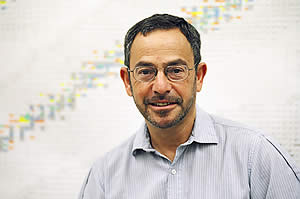Research in the Karol Group
 Nuclear and physical chemistry. Investigation of high-energy nuclear reaction mechanisms such as spallation and fragmentation. Development of rapid radiochemical separation techniques. Theory of column chromatography and applications to physicochemical studies. Positronium quenching models.
Nuclear and physical chemistry. Investigation of high-energy nuclear reaction mechanisms such as spallation and fragmentation. Development of rapid radiochemical separation techniques. Theory of column chromatography and applications to physicochemical studies. Positronium quenching models.
We are involved in the investigation of "deep spallation" reactions from both an experimental and a theoretical perspective. Deep spallation is a class of nuclear reaction between a fast projectile, perhaps from an accelerator or cosmic rays, and a target nucleus causing the ejection of a number of protons and neutrons or clusters. The objectives of our research are to deconvolve, insofar as possible, the two steps of the mechanism of high-energy interactions -- the fast cascade or knock-on step, and the slower evaporation step. Experiments are performed at the Los Alamos National Laboratory and elsewhere using particles accelerated to intermediate and high energies in order to induce complex nuclear reactions on targeted isotopes. Following rapid chemical separations, gamma-ray spectroscopy of short-lived radioisotopes is performed to determine absolute yields and recoil momenta of reaction products. Results from experiments serve as a means to probe the nature of collisions within the nucleus and to examine the behavior of atomic nuclei at very high temperatures (> 1012). In particular, the "kinetic theory of soft-sphere collisions" is employed to model projectile mean free-path calculations. Cascades of two-body collisions induced by incident beam particles produce residual systems in highly excited states which subsequently cool by "boiling off' additional neutrons, protons and more complex clusters, leaving final products easily distinguished from the original target by their radioactivity which is measured. The nuclear evaporation process and its inherent relationship to the nuclear equation of state at high temperature are under investigation from a theoretical perspective. The results of experiment and theory have applications which include radioisotope production, nuclear waste incineration and the propagation of ultrahigh energy cosmic rays through intergalactic space and in the atmosphere leading to "extensive air showers".
Work in our laboratories is also directed at the theory and application of very high-performance column chromatography. In particular, experiments that explore the dynamics of elution chromatography at and beyond the limit of conventional use in chemical analysis are of interest as are the development of new chromatographic techniques or uses in analytical chemistry. These include the extraction of thermodynamic and kinetic quantities from the degree of distortion of elution peak profile shapes. Computer simulations are used to obtain a clearer understanding of how to interpret data.
 Nuclear and physical chemistry. Investigation of high-energy nuclear reaction mechanisms such as spallation and fragmentation. Development of rapid radiochemical separation techniques. Theory of column chromatography and applications to physicochemical studies. Positronium quenching models.
Nuclear and physical chemistry. Investigation of high-energy nuclear reaction mechanisms such as spallation and fragmentation. Development of rapid radiochemical separation techniques. Theory of column chromatography and applications to physicochemical studies. Positronium quenching models.